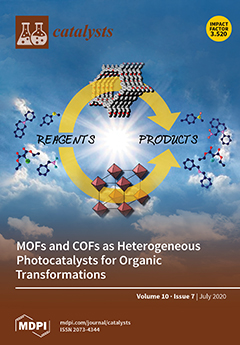Biodiesel obtained from palm oil over an environmentally friendly catalyst is highlydesirable. For that matter, dolomite, a natural material was used as a catalyst in this work, and this included potassium oxide (K
2O)-doped dolomite, 5 wt% K/D, 10 wt% K/D, 15
[...] Read more.
Biodiesel obtained from palm oil over an environmentally friendly catalyst is highlydesirable. For that matter, dolomite, a natural material was used as a catalyst in this work, and this included potassium oxide (K
2O)-doped dolomite, 5 wt% K/D, 10 wt% K/D, 15 wt% K/D, and 20 wt% K/D. X-ray diffraction analysis of dolomite revealed the CaO and MgO phases with high crystallinity, in which intensity reduced after doped with varying concentrations of K
2O. When the catalysts were evaluated, the K
2O-doped dolomite exhibited a better catalytic activity for palm oil transesterification. In the presence of K
2O, the methyl ester reached 98.7%, with the highest being displayed by 15 wt% K/D as compared to 87% over dolomite at reaction temperature of 60 °C, 12:1 methanol to palm oil ratio, 1 wt% catalyst amount and 1 h reaction time. SEM revealed that as more K
2O was doped on dolomite, the particles became more agglomerated, with a reduced BET surface area of 1.3 m
2/g in 20 wt% K/D as opposed to homogeneously small-sized MgO and CaO particles in dolomite with a high BET surface area of 19.0 m
2/g. However, the high activity of the doped catalyst was dictated by the high amount of basic site, as evidenced in TPD-CO
2 which showed an increase in the capacity of the basic site with an increased amount of K
2O. The catalyst was also reusable up to six times with a negligible decrease in activity due to K
+ leaching.
Full article





